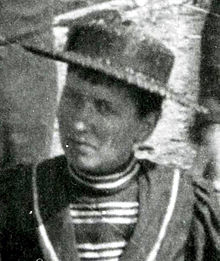Josephine Tilden
| Josephine Tilden | |
|---|---|

Tilden as part of a survey team
|
|
| Born |
Josephine Elizabeth Tilden March 24, 1869 Davenport, Iowa, US |
| Died | May 15, 1957 (aged 88) Florida, US |
| Nationality | American |
| Education | University of Minnesota |
| Occupation | Researcher and academic |
| Employer | University of Minnesota |
| Known for | Algology and travel |
Josephine Elizabeth Tilden (March 24, 1869 – May 15, 1957) was an American expert on algae. She was the first woman scientist employed by the University of Minnesota. Tilden established a research station in British Columbia which lasted only until 1906. Tilden traveled widely and particularly around the Pacific Ocean to collect unusual samples of flora. Tilden also created an important collection of algae which she took from the university and kept in her house for further study after she retired.
Tilden was born in Davenport, Iowa and grew up in Minneapolis. She showed an early interest in plants and she had published a paper on the local botany before she began her association with the University of Minnesota. In 1895, she earned a bachelor's degree followed by a masters the following year from the university. In 1897 she wrote a paper on algal stalactites, a phenomenon that she had discovered near a geyser in Yellowstone Park.
She became an instructor at her alma mater, where she took a peculiar interest in algology, becoming the first woman scientist on the staff. Her superiors at the university were concerned, but they agreed to fund this interest in return for her promise to commit to the subject for at least five years. In fact, Tilden gave a commitment that would last until she died. Her first trip to the Pacific was a journey to Vancouver Island. On many of these journeys she was accompanied by her mother.
Tilden was the leading force of the establishment of the Minnesota Seaside Station in Canada. She discovered an untouched area of land in British Columbia which had a good environment for observing and collecting algae. The land owner gave her the area for free, and she chose four acres that were ideal to create an algae research station. The area was known as Botanical Beach in what is now Juan de Fuca Provincial Park in British Columbia. Tilden used her own funds to build the research station. In 1902 Conway MacMillan published a long description of the new station claiming a benefit of its location in that all the students had to take an important journey across North America to get there. Tilden became an assistant Professor in 1903; she was the first female scientist employed by the University of Minnesota. Tilden in turn offered this land and the buildings that were on it to her university. Despite the entreaties of Professor Conway MacMillan and herself the university refused to take responsibility for land in a different country. MacMillan resigned over this issue.
...
Wikipedia
